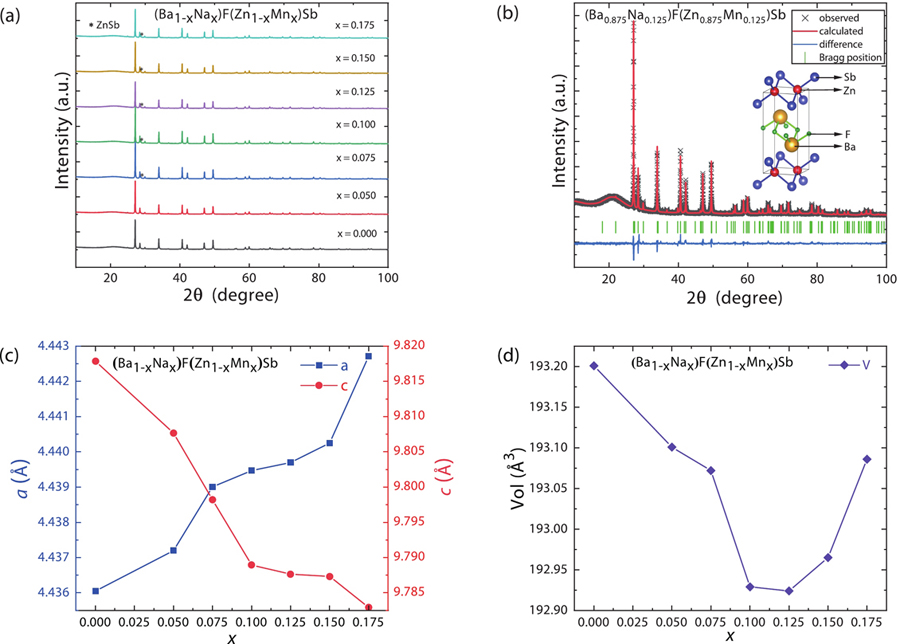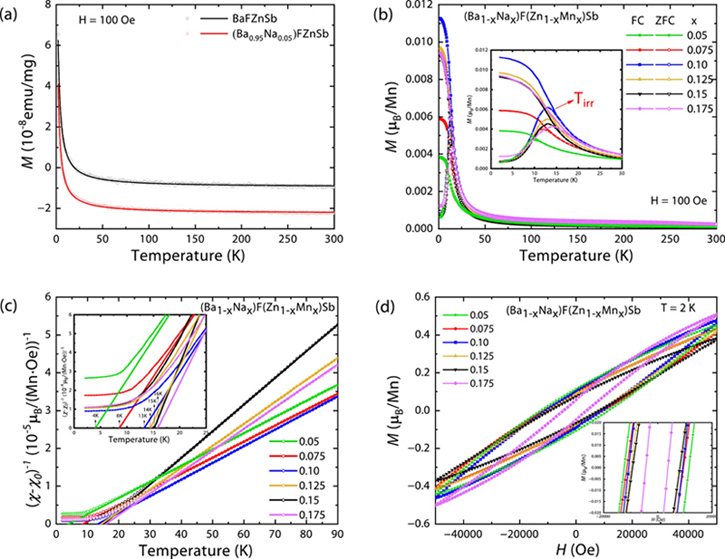Xueqin Zhao, Jinou Dong, Licheng Fu, Yilun Gu, Rufei Zhang, Qiaolin Yang, Lingfeng Xie, Yinsong Tang, Fanlong Ning. (Ba1−xNax)F(Zn1−xMnx)Sb: A novel fluoride-antimonide magnetic semiconductor with decoupled charge and spin doping[J]. Journal of Semiconductors, 2022, 43(11): 112501
Search by keywords or author
- Journal of Semiconductors
- Vol. 43, Issue 11, 112501 (2022)

Fig. 1. (Color online) (a) The polycrystal powder X-ray diffraction patterns of (Ba1−xNax)F(Zn1−xMnx)Sb (x = 0.00, 0.05, 0.075, 0.10, 0.125, 0.15, and 0.175). Traces of impurities ZnSb are marked as stars (*). (b) The Rietveld refinement result of (Ba0.875Na0.125)F(Zn0.875Mn0.125)Sb. Inset shows the tetragonal ZrCuSiAs-type crystal structure of parent compound BaFZnSb. (c) Lattice parametersa andc versus doping levelx of (Ba1−xNax)F(Zn1−xMnx)Sb (x = 0.00, 0.05, 0.075, 0.10, 0.125, 0.15, and 0.175). (d) The unit cell volume of (Ba1−xNax)F(Zn1−xMnx)Sb (x = 0.00, 0.05, 0.075, 0.10, 0.125, 0.15, and 0.175).

Fig. 2. (Color online) (a) The temperature dependence of DC magnetization for parent phase BaFZnSb and (Ba0.95Na0.05)FZnSb under field-cooling mode in an external magnetic field of 100 Oe. The data (open circles) are the data dots, and the solid lines are the Curie-Weiss fitting results. (b) The temperature dependent magnetization (M) for (Ba1−xNax)F(Zn1−xMnx)Sb (x = 0.05, 0.075, 0.10, 0.125, 0.15 and 0.175) in both zero-field-cooling (ZFC) and field-cooling (FC) procedures under an external magnetic field of 100 Oe. Inset shows the enlarged M(T) curves for all specimens at low temperature. Arrow marks
Fig. 3. (Color online) The (a) real part
Fig. 4. (Color online) Temperature-dependent resistivity measurements for (Ba1−xNax)F(Zn1−yMny)Sb (x = 0.00,y = 0.00;x = 0.05,y = 0.00;x = 0.05,y = 0.05;x = 0.075,y = 0.075;x = 0.10,y = 0.10;x = 0.125,y = 0.125;x = 0.15,y = 0.15;x = 0.175,y = 0.175).
|
Table 1. The Weiss temperatureθ, the base temperature magnetic moment

Set citation alerts for the article
Please enter your email address



